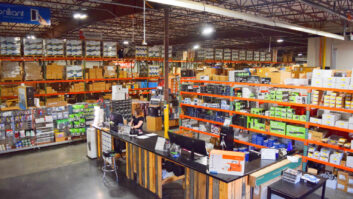TWICE: What is the greatest challenge facing the extended-service contract industry?
Dawn Morris, president, Bankers Warranty Group: One of the biggest challenges in the extended- service industry for 2015 and moving forward lies within online retail and the rapid growth that is associated with it. Consumers are researching products and making purchasing decisions via these online resources. This disconnects the face-to-face interaction from the sale of an extended warranty, causing a need for the warranty to have a strong presence on these online retail sites.
Justin Thomas, senior VP, North America consumer products and third-party administrator segment, The Warranty Group: In today’s environment it isn’t enough to have an obligor company, an administrative company or even a wholly owned insurance company anymore. And it certainly isn’t enough to provide coverage that looks like everyone else’s.
The competitive landscape for our space is getting more and more crowded. Multinational, historically non-traditional players are entering at a rapid pace. New distribution channels appear regularly. These two factors in combination with the consumers’ increased service expectations are correctly pushing our industry to think differently about what our business is today.
The environment is further complicated by the fact that so many of us leverage the same supply chain and service networks, the majority of which none of us own or operate. So differentiation becomes that much more difficult to achieve.
Sean Stapleton, president/CEO, Warrantech: A significant challenge faced by our industry continues to be retail margin compression. As a result of the fierce competition between retailers for customers, retailers have few choices but to generate savings in other parts of their businesses. Extended-service contract programs are certainly high on the list of many retailers as an opportunity to retain additional revenue. The result is that administrators and their respective underwriters are forced to try to become more efficient or reduce claims funds to compete.
While competition should be seen as a positive force in business, this continued underwriting pressure could lead to administrators underpricing programs to win opportunities. This will likely result in programs being underwater, thereby leading to frantic attempts by the administrators and their underwriters to reduce both administration expenses and claims costs. The likely downstream effect will be negative customer experiences and further diminished customer loyalty.
Ty Shay, chief marketing and customer experience officer, SquareTrade: Our industry faces the challenge of keeping up with changing consumer habits and needs, and the dynamic landscape of mobile technology, depot processes and repair options. We must constantly innovate our product to meet these changing needs, while keeping our pricing fair and our service excellent. This past holiday season was our busiest one ever, and we found that our attention to these market dynamics paid off enormously.
Sean Hicks, CEO, New Leaf Service Contracts: We think one of the biggest challenges for the industry on the CE side is continuing to create products that follow the industry trends. Convergence is real and it is here. Selling a service contract on a television or an appliance is our bread-and-butter business but we need to evolve with the industry and create products and services for the connected home. Customers are buying alarm systems, home-theater systems, whole home audio systems, and they want to have service contracts that cover them all.
On the appliance side of things the biggest challenge is controlling the loss costs. Appliances are not what they were and parts for even newer products are hard to get at times. Finding creative solutions to rebuild parts is in full swing.
Jeff Unterreiner, senior VP, Connected Living, Assurant Solutions: The biggest challenge for the service contract industry is the same challenge that the overall consumer electronics industry faces, which is to stay ahead of evolving consumer preferences in this new connected world. It’s not easy. Studies show that most consumers can’t tell you exactly what they want from smart products, just that they will know it when they see it. That’s why we formed our Connected Living business [see story, p. 19] and why we focus on generating actionable insights for our clients through ongoing consumer research.
Kevin Callahan, senior VP, U.S. service programs, AIG: Warrantable product sales in the core categories – PCs, appliances, consumer electronics – seem flat; however, the convergence of multiple products into a single mobile device is creating significant opportunities for non-traditional warranty coverages such as for privacy, identity and reputation protection.
TWICE: Conversely, where do the industry’s greatest opportunities lie?
Chuck Stewart, senior VP, Asurion Retail Solutions: Over the past decade we’ve seen tremendous innovation and diversification across consumer goods and technology. From an industry perspective, this has revolutionized consumer buying trends and redefined the product ownership experience.
Given the increasing proliferation of technology in everyday devices such as appliances, wearables and computing, which is fueled by competitive OEMs looking for growth opportunities, consumers now have an incredible variety of connected devices from which to choose.
Three key trends will provide retailers with opportunity: First, proliferation of these connected devices; second, increasing dependence of consumers on technology in order to work, socialize, learn, stay healthy and be entertained; and third, the inherent complexity boom that is coming from having to use and support all of these devices.
Consumers will not only need a protection and service solution across the device lifecycle, but also comprehensive support and a seamless experience to address the complexity and technical issues that will result from having and using multiple devices. Retailers have the opportunity to provide customers with an exceptional point-of-need experience, spanning protection and support, to ultimately drive satisfaction and loyalty for that next purchase.
Jennifer Monasterio, president, Mack Worldwide Warranty: The biggest challenge and greatest opportunity is the ever growing online and mobile sales market. How will extended warranty providers increase sales and gain market share online?
Mack continually provides online point-of-sale and promotional material. We are also releasing a new online commercial for e-commerce dealers so that online consumers will be able to better understand the benefits of purchasing a Mack extended warranty. In addition, our custom e-commerce application may be integrated with any website to give the consumer the option to purchase a warranty during the checkout process.
During the redesigning process of our current website and dealer portal we worked with developers to keep in mind that more people than ever are using tablets and cellphones to surf the web. Our goal was to create a mobile version of our site that would be easily viewed on all devices as well as your PC. With this in mind, consumers may use any of their devices to research our product information.
Morris: With every challenge comes an opportunity. Fortunately, the rapid growth of online retail opens a door to a new opportunity to attract the millennials to customized service solutions that coincide with their online and mobile buying habits. This targeted consumer audience is technology driven. Since online purchasing is becoming more prevalent, there is a need to present the service plan in an innovative and influential way. Providers must differentiate the presentation of the program to achieve attachment rates equivalent to brick-and-mortar stores.
Shay: In an environment where mobile devices have become endlessly useful, being without them is an enormous hardship. It naturally follows that warranties that deliver fast repair or replacement are increasingly popular. Consumers want options of how and where to solve this immediate need to get connected again.
Callahan: Many non-traditional distribution channels, such as affinity groups, are looking at ways to bundle value-added benefits and services like loss/ theft and travel insurance into their product offerings, creating opportunities for service program providers. Telematics, which provide real-time data feedback from devices such as smart thermostats, is emerging as another warranty growth opportunity, as consumers increasingly rely on these products to remotely control and monitor their home products. Opportunities also exist in providing consumers with varying billing methods – monthly, quarterly and so forth – that coincide with how they pay for or acquire services surrounding their product purchase.
Hicks: One of the biggest challenges is also one of the greatest opportunities: convergence. The company that comes up with the right product that resonates with the consumer will have a great opportunity.
For New Leaf specifically, the biggest challenge and opportunity for us is to continue to get our message out to the retail community. We are the only independent service contract administrator that has multiple underwriting solutions that focus on the mid- and small-market retailers. We have developed the systems and products to allow these markets to exceed the services offered by the big- box retailers, and we need to continue to share our message.
Stapleton: The greatest opportunity for our industry will be the development of protection solutions that allow customers to cover a broad spectrum of devices and equipment utilizing diverse payment mechanisms. Warrantech has developed solutions that better enable customers to purchase protection plan products in a convenient manner, covering more items, and providing additional value that ultimately will result in additional revenue and customer satisfaction for our partners.
Unterreiner: People are becoming increasingly dependent on connected products to manage their lives, creating the opportunity to help consumers stay connected to the devices, products and information they need. The companies that can keep consumers connected and that can quickly re-connect them when there is a disruption are poised for success in the connected living marketplace. That’s why our focus is on helping consumers stay connected to their worlds and helping clients stay connected to their customers.
Thomas: The [challenging] environment also provides for incredible opportunity with the right line of thinking. From our perspective, we start every conversation with the consumer as the focus. What kind of protection products do they want? How does today’s definition of “customer service” differ from five or ten years ago?
We put ourselves in the consumer’s shoes, and then cultivate solutions that are cost balanced, easy to understand, and user-friendly. Our primary strength continues to be our ability and willingness to be completely transparent with our clients, and provide thoughtful, customized solutions across the globe.












